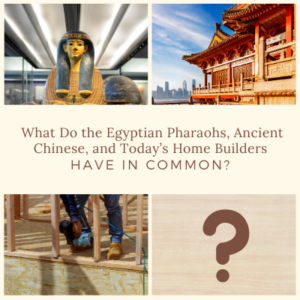What Do the Egyptian Pharaohs, Ancient Chinese, and Today’s Home Builders Have in Common?

Plywood is an engineered wood panel that is comprised of thin veneers of wood that are adhered with an adhesive. It is commercially produced in 4×8 ft sheets that are readily available at hardware and lumber stores. Plywood has been around for decades and most people have a general understanding of it. Plywood was patented in the U.S. as a construction material at the close of the Civil War, which led to industrial advances including glued laminated (glulam) timber, wood I-joists, laminated veneer lumber (LVL), and other engineered wood panel (EWP) products. Today, builders are increasing their reliance on EWP to provide unique solutions for single-family home construction, as well as for apartments, schools, warehouses, restaurants, hotels and other multi-story structures.
However, most people do not realize the rich history of plywood. Traces of laminated wood have been found in the tombs of the ancient Egyptian Pharaohs. The Chinese shaved wood and glued it together for furniture as early as 1000 CE. These products may not be what we call plywood today but they certainly have some similarities, and they make me recall Ecclesiastes 1:9, “What has been will be again, what has been done will be done again; there is nothing new under the sun.”
Any ancient bonded wood product must have some sort of adhesive. Adhesives may be defined as any substance capable of attaching materials together by means of surface attachment. This property is not necessarily an intrinsic characteristic of the substance itself since the adhesive may be much weaker than the materials joined together, but it is developed as the adhesive interacts with the adherends under certain conditions of temperature and pressure. The ancient Egyptians knew well the art of veneering and used adhesives to attach decorations to wood some 3500 years before Christ. Mud, dung, and clay, along with mixtures of these substances, must also be regarded as adhesives and have been used for centuries to build huts in many parts of the world. Thatched huts plastered with a mixture of camel’s dung and mud are still regularly used in southwestern Saudi Arabia.
Animal blood is an old adhesive that is still used in some developing countries for interior grade plywood. Today, most exterior grade plywood is bonded with phenol formaldehyde. According to the book “Plywood and Adhesive Technology” by Terry Sellers, in the US during World War II phenol was on strict allocation and dried animal blood (protein) was used to extend the phenolic adhesive formulations for plywood. The blood extension was applied in the true sense of an extender wherein a substance having adhesive action is added to another adhesive to reduce the amount needed off the primary adhesive (phenol formaldehyde) per unit area. As phenol became more scare, more blood was used in the formulations.
So, next time you purchase a sheet of plywood for a project at your house. Stop for a second and reflect on how this product has advanced through the years. You are using a technology that is very similar to that used by the ancient Egyptians.
Meet the Author
Dr. Todd Shupe is the President of Wood Science Consulting, LLC. He is a well-recognized expert on wood forensics, wood preservation, wood decay and degradation, and wood species identification. He has a broad background in new product development, quality management, and marketing and sales in both the public and private sectors. For more information please visit DrToddShupe.com.
We welcome your comments below.
Thank you for visiting. We trust that you have enjoyed reading our articles.
Liked this post? Read more below or search for more topics . . .

